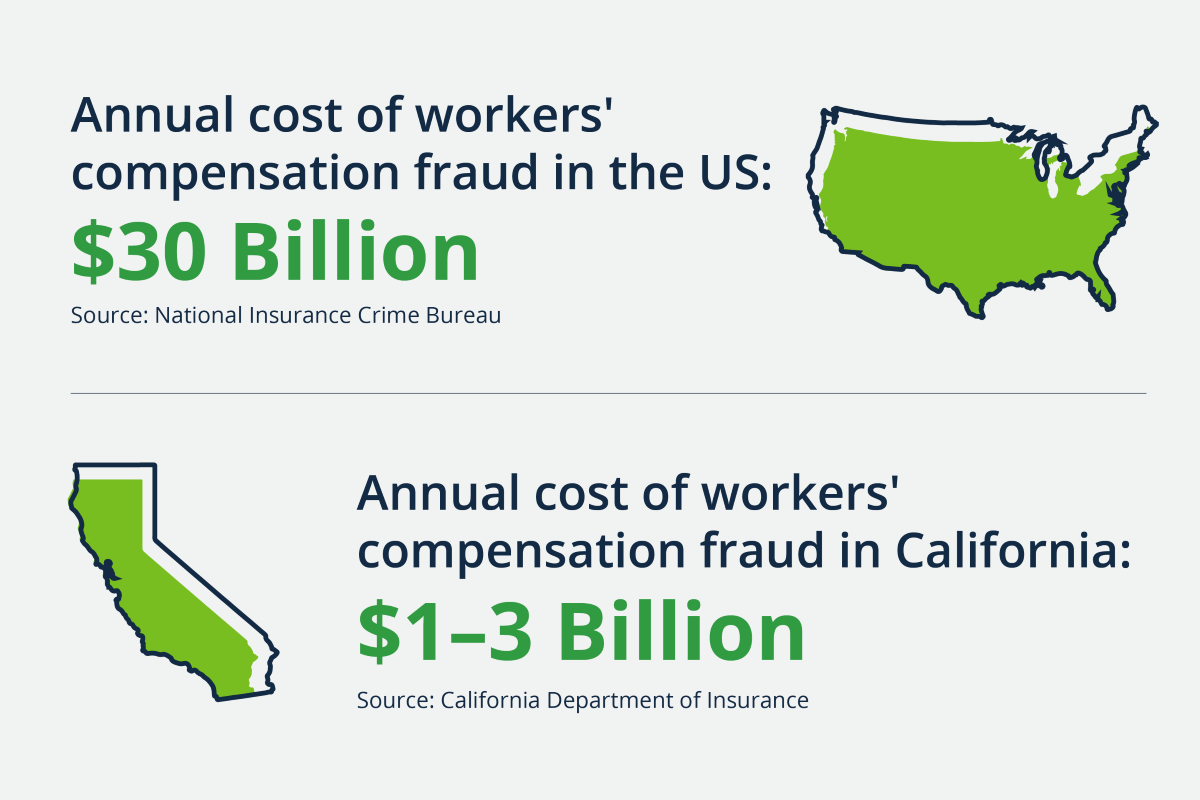Blog
Workers' Compensation Investigations: The Why, When, and How
Workers’ compensation claims are costly and can drag on for years. The average cost of a lost time claim (indemnity and medical only) in California has increased from $54,712 in 2018 to $58,843 in 2021, according to the Workers’ Compensation Rating Bureau (WCIRB). The WCIRB projects a steady increase in average indemnity costs through 2024, primarily driven by continued increases in average wages.

When an injured worker has been off work for months on end and they are not working modified duty, you may want to consider opening an investigation to determine the injured worker’s activity level. Employers sometimes hear from coworkers that the injured worker is out golfing, playing tennis, fishing, or working a side job when they are receiving temporary disability. This is the type of scenario where you, as the employer, should alert the insurance carrier or your broker that you have information that could impact the injured worker’s benefits. If the primary treating physician (PTP) states the injured worker is precluded from twisting or raising their arms above shoulder level, and a coworker tells the employer they saw the injured worker golfing, the next step would be to request an investigation to determine if the injured worker’s activity level is beyond what the PTP says the injured worker can perform.
While most workers’ compensation claims are valid, there is significant abuse within the system. An injured worker may exaggerate their symptoms to be taken off work for a longer period or claim an injury is work related when the injured worker injured themselves at home over the weekend.
Identifying fraud is critical for employers because workers’ compensation claims have material direct and indirect costs.
Direct costs are expenses typically covered by your workers’ compensation insurance carrier and include:
- Lost time wages (temporary or permanent disability)
- Medical treatment or vocational rehabilitation
- Investigation and legal fees
Indirect costs are unexpected costs not covered by your workers’ compensation policy and can vary by injury:
- Wage and hour costs: This includes compensation to perform the injured worker’s duties during their leave, including overtime, a temporary employee, or a new hire.
- Loss of productivity: It takes time to train a temporary replacement, who is less experienced and likely less efficient.
- Company culture: Other employees may have low morale as they may be resentful toward an injured worker who is on light duty or who they suspect may not be as injured as they claim.
These costs can be reduced by actively managing your workers’ compensation claims.

Types of Workers' Compensation Investigations
Fortunately, there are various ways to investigate and potentially mitigate workers' compensation claims. Investigations should be assigned by the insurance carrier or third-party administrator and employers should not hire an investigator directly. Here are the types of investigations your carrier may conduct:
Background Check
Background checks are an inexpensive way to obtain an injured worker’s criminal history (felony and misdemeanor criminal convictions, any pending criminal cases, and history of incarceration as an adult), aliases, addresses, and owned vehicles. Background checks can be used to locate an injured worker who is not responding to settlement attempts or to assist the investigator with other potential locations to obtain surveillance.
Medical Canvas
A medical canvas is performed to determine if an injured worker is receiving treatment outside the workers’ compensation system. If the medical canvas shows the injured worker is being treated at other clinics, those records can be subpoenaed to determine if the injured worker has any underlying non-industrial conditions.
Social Media Check
Social media checks are less costly to perform because it does not involve actual surveillance. Many social media profiles are public, and an investigator can run a check to see what is being posted by the injured worker, their family members, and friends. The information gleaned from the social media check can provide context to the investigator, who can then conduct more targeted surveillance.
For example, if an injured worker’s Instagram account shows them playing softball on Wednesday evenings, the investigator will focus their surveillance on Wednesdays in the late afternoon to evening. The post may even identify where the injured worker plays softball, and the investigator can have one investigator follow the injured worker from their home and another investigator wait at the softball location.
Activity Check
The investigator conducts a preliminary inquiry by visiting the injured worker’s home, interviewing neighbors, and obtaining basic information about the injured worker, such as who they live with or whether they have young children. Adjusters use activity checks to determine if the employee is where they say they are (such as at home recovering from an injury). The investigator will look for clues that an injured worker is active, such as dirty work boots or a wetsuit hanging up to dry in an open garage and can take photos as evidence. If the injured worker is active during the activity check, the investigator will commence surveillance and film the activity.
Surveillance
This is the most in-depth and expensive type of investigation because it involves an investigator following the injured worker to determine their activity level. The investigator will provide photographic and video evidence of the injured worker’s activities. This is also the riskiest type of investigation to perform because the investigator can lose the injured worker in traffic, the injured may notice they are being filmed, or the location is not conducive to surveillance (such as gated communities).
More recently, unmanned surveillance vehicles are used to discreetly surveil an injured worker 24 hours a day for three to five continuous days. These stationary vehicles are non-intrusive and the surveillance equipment in them is remotely operated and monitored by investigators. This technology allows the investigator to view the subject in real-time to determine the injured worker’s comings and goings.
This type of investigation is cost-effective because the investigator is not on location. Unmanned surveillance is often used in more rural areas when a parked surveillance van may draw attention. The information gathered during unmanned surveillance is leveraged to determine if manned surveillance is needed and the best times to send the investigator to follow the injured worker. If unmanned surveillance shows the injured worker inactive for several days, it is likely that manned surveillance would not be warranted.
Activity checks and various types of surveillance are costly. An insurance carrier will weigh the potential benefit of good surveillance versus the cost to do the investigation. If an injured worker is not losing time from work, the insurance carrier is less likely to assign surveillance because lost wages are not being paid.
When to Ask for an Investigation
Most claims are valid, but how do you know when one isn’t? Learn the red flags and communicate them to the claim consultant so they can contact your insurance carrier to investigate.
Below are some red flags to watch for:
- The injured worker is disgruntled.
- The injured worker’s description of the accident keeps changing or evolving.
- The injury is reported late or after a weekend.
- The injured worker is difficult to reach by phone.
- The injured worker’s subjective complaints outweigh a doctor's objective findings.
- The injured worker appears to be doctor shopping.
- Work restrictions are overly strict or remain unchanged despite medical treatment and time.
- The injured worker’s outside hobbies and interests don't align with their injuries.
- The injured worker has concurrent employment.
Investigate Early and Manage the Claim
If you have doubts at the onset of a workers’ compensation claim, bring all red flags and concerns, no matter how insignificant they may seem, to the attention of the insurance carrier and your Woodruff Sawyer team and adjuster. The initial investigation is just as important as the ongoing investigation tools we reference in this article.
No employer wants a questionable claim that requires an investigation, but there is a positive side to it. When other employees see their employer investigating claims, they may be less likely to file a fraudulent claim since they know their employer takes these matters seriously.
Ensure there is a proper investigation ongoing throughout the life of the claim. Circumstances change, and the injured worker may be involved in a subsequent injury outside of work that could impact the claim. The claim may start as legitimate but may not stay that way. Perhaps the injured worker becomes comfortable staying at home and begins providing childcare, saving money on babysitting fees while collecting disability benefits. That could disincentivize them from returning to work.
While a claim is being investigated, ask the adjuster to look for early settlement opportunities, such as during the deposition of the injured worker. The longer the claim remains open, the costlier it becomes, and the harder it is to settle the claim for a nuisance amount.
We recommend you contact your Woodruff Sawyer team when considering investigating a claim. Have a discussion with your claim consultant when deciding on the investigation options, and they will guide you through the process.
Authors
Table of Contents
















